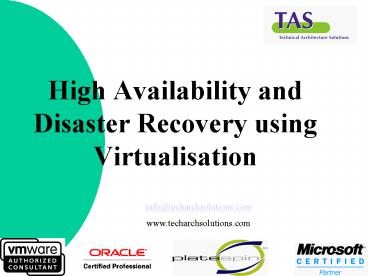High Availability and Disaster Recovery using Virtualisation - PowerPoint PPT Presentation
1 / 21
Title:
High Availability and Disaster Recovery using Virtualisation
Description:
High Availability and Disaster Recovery using Virtualisation. info_at_techarchsolutions.com ... data and restart business operations in the event of a disaster ... – PowerPoint PPT presentation
Number of Views:81
Avg rating:3.0/5.0
Title: High Availability and Disaster Recovery using Virtualisation
1
High Availability and Disaster Recovery using
Virtualisation
info_at_techarchsolutions.com www.techarchsolutions.c
om
2
Definitions
- HA ability to proactively avoid some types of
disasters before they occur - DR ability to quickly recover data and restart
business operations in the event of a disaster
3
Traditional HA solutions - Clustering
- Purpose
- High Availability
- Scalability/Load Balancing
- Manageability
- Types
- Active/Active
- Active/Passive
- Cold Failover
- Hot Failover
4
Traditional HA solutions - Clustering
- Benefits
- Reduced probability of disaster occurrence
- Reduced planned downtime windows and costs
- Improved operational efficiencies
- Disadvantages
- Expensive IT investment
- Active / Passive clusters waste hardware
- Complex implementation
5
Current DR solutions
- Media-based backup/restore
- Good Familiar, cheap
- Bad slow, high cost of downtime
- Cold Standby
- Good server availability
- Bad wasted hardware
- Hot Standby
- Good quick turnaround time, multitasking
- Bad expensive
6
What is Virtualisation?
- Multiple virtual systems residing on a physical
server. - Provides a layer of abstraction between the
hardware and software that runs on it.
7
Virtualisation as an Option
- Disadvantages
- Not recommended for servers that are heavily
utilised - Not recommended for applications/servers
requiring specific hardware requirements - If designed badly, single point of failure
- Advantages
- Greater solution ROI
- Savings on hardware and rack space
- Ease of management
- Efficiency in deployment of VMs
- Zero-downtime hardware maintenance
- Higher SLA and DR at a lower cost
8
Clustering for Higher Availability in a Virtual
Infrastructure
- Cluster Virtual Machines for High Availability
- Cluster host servers for High Availability
- Application Clustering
- Virtual Infrastructure can be a replacement for
clusters where clustering for H/W failure only
9
Virtual Machine HA solutions
- VMs can be run from any server in a pool
- VMs can be dynamically moved between servers
10
Virtual Machine HA solutions
- VMs from a failed server can be brought back
on-line in remaining server pool quickly
(within/across DCs)
11
Clustering with Virtual Machines
- Cluster between physical and virtual machines
- Cluster-in-a-box
- VM Clustering between 2 Host Servers
12
Physical-to-Virtual Clustering
- Physical machine clustered with a Virtual Machine
- Shared storage required
13
Cluster in a Box
- One VM is primary and second is backup
- Quorum on shared storage
14
VM clustering between two servers
- VM on one host is primary, VM on second host is
backup - Shared storage required
15
Virtual DR solutions
- VMotion between DCs
- SAN mirroring between DCs
- Snapshot and copy between DCs
- Snapshot to tape or file server
- Physical to virtual DR
16
Virtualisation Vendors
- Xen
- Solaris Zoning
- Microsoft Virtual Server 2005
- VMware ESX
17
Migration Tools for Virtualisation
- Microsoft VSMT
- Leostream PgtV direct
- VMware P2V Assistant
- Platespin PowerConvert
18
PlateSpin PowerConvert
19
PlateSpin PowerConvert Solutions
- Consolidation
- Recovery
- Test lab automation
- Business Service Provisioning
- Hardware migrations
- Data Centre Moves or Centralisation
20
Future of Virtual Infrastructure
- Host server clustering ability to automatically
bring up VMs on secondary server in the event of
failure - Integration of the system failure detection card
into the ESX layer - Self managing Data Centres
- Application virtualisation (Softgrid Softricity)
21
QUESTIONS
- ???????????????????????????

